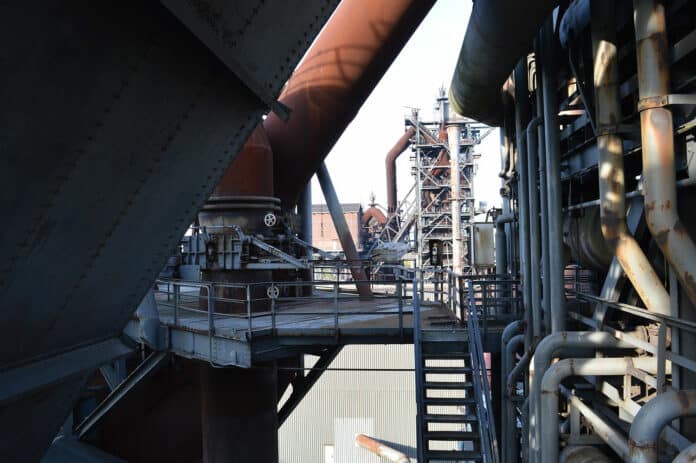The iron and steel sector is a major greenhouse gas emitter, releasing 7-9% of global carbon dioxide (CO2) emissions. That’s because of the inherent carbon-intensive nature of its production.
Now, researchers from the University of Birmingham have designed a novel adaptation for existing iron and steel furnaces that could reduce CO2 emissions from the steelmaking industry by nearly 90%. They achieved this through a ‘closed loop’ carbon recycling system, which could replace 90% of the coke typically used in current blast furnace-basic oxygen furnace systems and produces oxygen as a bi-product.
Around 70% of the world’s steel is produced via gigantic blast furnaces, which are used to make iron from iron ore, and basic oxygen furnaces, which turn that iron into steel. In blast furnace steel manufacturing, metallurgical coke – produced by destructive distillation of coal in a coke oven – is used to produce metallic iron from ore obtained from mining.
The top gas from the furnace contains mainly nitrogen, carbon monoxide (CO), and CO2, which is burned to raise the air blast temperature up to 1200 to 1350oC in a hot stove before being blown to the furnace, with the CO2 and N2 emitted to the environment.
Devised by Professor Yulong Ding and Dr. Harriet Kildahl from the University of Birmingham’s School of Chemical Engineering, the novel recycling system captures this CO2 from the top gas and converts it into carbon monoxide that can be reused in the iron ore reaction. A crystalline mineral lattice known as a ‘perovskite’ material is used for the thermochemical splitting of CO2, a viable candidate due to its low reaction temperatures, high carbon monoxide yields, and 100% selectivity towards CO.
The double perovskite material splits CO2 into carbon monoxide at around 800 °C and the oxygen, which is absorbed into the lattice. The oxygen produced can be used in the basic oxygen furnace to produce steel.
The carbon monoxide produced by the thermochemical cycle replaces expensive metallurgical coke for the reduction of iron ore to metallic iron in the blast furnace. The CO2 produced from the blast furnace is used in the thermochemical cycle to produce more CO, therefore creating a closed carbon loop, allowing for the decoupling of steel production from greenhouse gas emissions.
According to the researchers, if implemented in the UK alone, it could deliver cost savings of £1.28 billion in 5 years while reducing overall UK emissions by 2.9%.
“Current proposals for decarbonizing the steel sector rely on phasing out existing plants and introducing electric arc furnaces powered by renewable electricity,” said Professor Ding. “However, an electric arc furnace plant can cost over £1 billion to build, which makes this switch economically unfeasible in the time remaining to meet the Paris Climate Agreement. The system we are proposing can be retrofitted to existing plants, which reduces the risk of stranded assets, and both the reduction in CO2 and the cost savings are seen immediately.”
The University of Birmingham Enterprise has filed a patent application covering the system and its use in metal production. It is currently looking for long-term partners to participate in pilot studies, deliver this technology to existing infrastructure, or collaborate on further research to develop the system.
Journal reference:
- Harriet Kildahl, Li Wang, Lige Tong, Yulong Ding. Cost-effective decarbonization of blast furnace – basic oxygen furnace steel production through thermochemical sector coupling. Journal of Cleaner Production, 2023; DOI: 10.1016/j.jclepro.2023.135963
